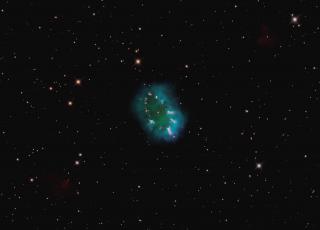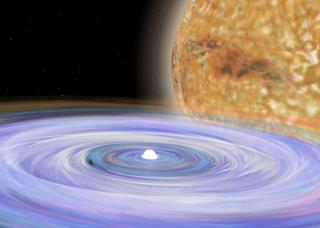Bibcode
Corradi, R. L. M.; Sabin, L.; Miszalski, B.; Rodríguez-Gil, P.; Santander-García, M.; Jones, D.; Drew, J. E.; Mampaso, A.; Barlow, M. J.; Rubio-Díez, M. M.; Casares, J.; Viironen, K.; Frew, D. J.; Giammanco, C.; Greimel, R.; Sale, S. E.
Referencia bibliográfica
Monthly Notices of the Royal Astronomical Society, Volume 410, Issue 2, pp. 1349-1359.
Fecha de publicación:
1
2011
Número de citas
120
Número de citas referidas
88
Descripción
IPHASX J194359.5+170901 is a new high-excitation planetary nebula with
remarkable characteristics. It consists of a knotty ring expanding at a
speed of 28 km s-1, and a fast collimated outflow in the form
of faint lobes and caps along the direction perpendicular to the ring.
The expansion speed of the polar caps is ˜100 km s-1,
and their kinematical age is twice as large as the age of the ring.
Time-resolved photometry of the central star of IPHASX J194359.5+170901
reveals a sinusoidal modulation with a period of 1.16 d. This is
interpreted as evidence for binarity of the central star, the brightness
variations being related to the orbital motion of an irradiated
companion. This is supported by the spectrum of the central star in the
visible range, which appears to be dominated by emission from the
irradiated zone, consisting of a warm (6000-7000 K) continuum, narrow C
III, C IV and N III emission lines, and broader lines from a flat H I
Balmer sequence in emission.
IPHASX J194359.5+170901 helps to clarify the role of (close) binaries in
the formation and shaping of planetary nebulae (PNe). The output of the
common-envelope (CE) evolution of the system is a strongly flattened
circumstellar mass deposition, a feature that seems to be distinctive of
this kind of binary system. Also, IPHASX J194359.5+170901 is among the
first post-CE PNe for which the existence of a high-velocity polar
outflow has been demonstrated. Its kinematical age might indicate that
the polar outflow is formed before the CE phase. This points to mass
transfer on to the secondary as the origin, but alternative explanations
are also considered.
Proyectos relacionados

Nebulosas Bipolares
Nuestro proyecto persigue tres objetivos principales: 1) Determinar las condiciones físico-químicas de las nebulosas planetarias con geometría bipolar y de las nebulosas alrededor de estrellas simbióticas. El fin es entender el origen de la bipolaridad y poner a prueba los modelos teóricos que intentan explicar la morfología y la cinemática nebular
Antonio
Mampaso Recio

Estrellas Binarias
El estudio de las estrellas binarias es una parte esencial de la astrofísica estelar. Una gran parte de las estrellas de nuestra Galaxia y de otras galaxias se ha formado en sistemas binarios o múltiples, por lo que entender la estructura y evolución de estos sistemas es importante desde el punto de vista estelar y galáctico. Un aspecto en el que
Pablo
Rodríguez Gil